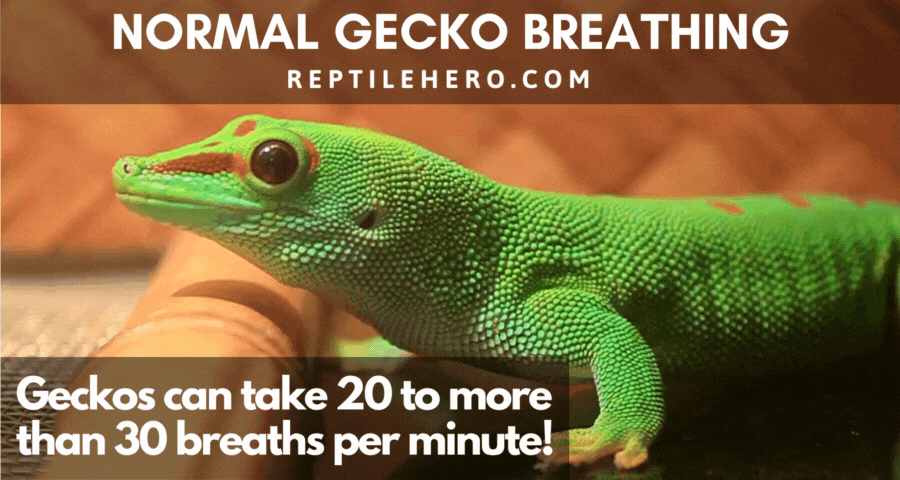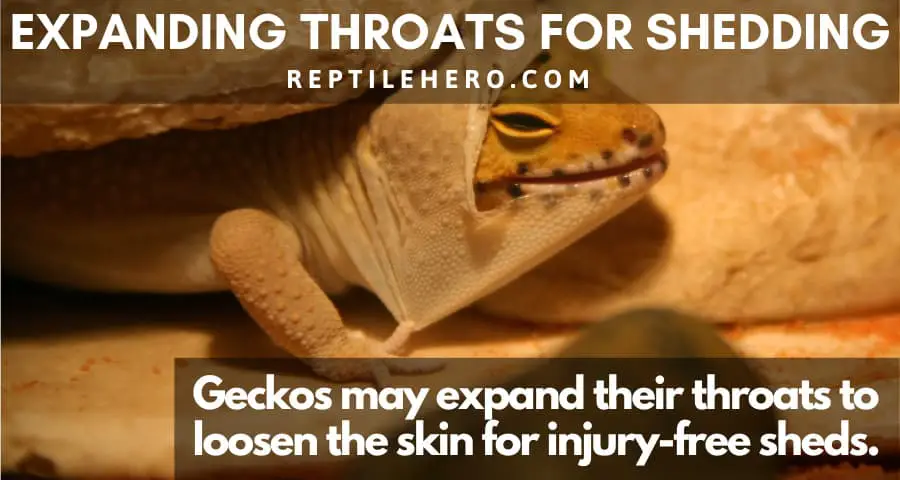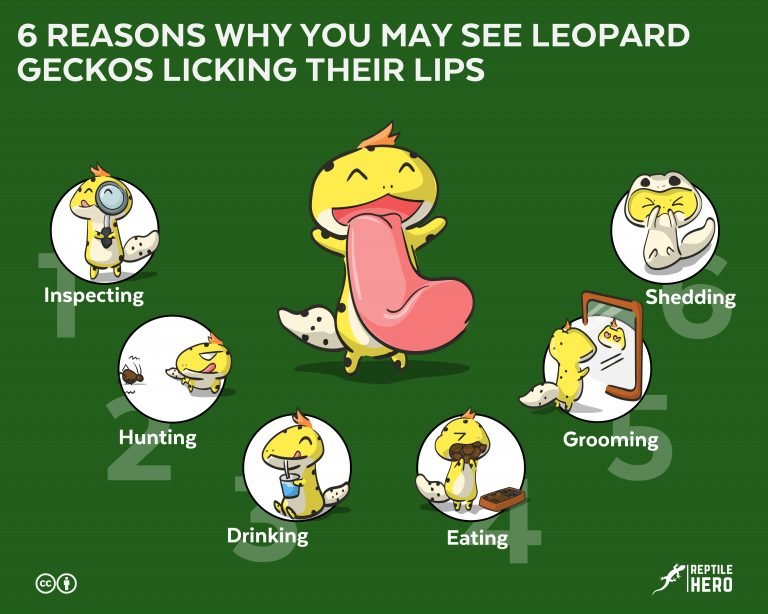Why is My Gecko’s Throat Puffing and Moving Fast?
Geckos don’t normally bare their throats for all to see since it’s a vulnerable spot, so what does it mean when they start expanding it? Do they do it to attract mates like other colorful lizards? Or is a gecko that’s enlarging its throat actually having trouble breathing?
Puffing throat is normal and harmless in geckos. Geckos puff their throat more prominently during mating. Nonetheless, this behavior, to a lesser extent, can be observed even while breathing, roaming, swallowing, and shedding. If a gecko displays other abnormal behaviors, like lethargy, or if a mass forms around its throat, professional help is needed.
Due to their relatively small size, we often miss out on things that our precious geckos often do. So if it’s your first time seeing your gecko puff out its throat, don’t panic! Read on to find out when throat inflation is bad for your pet geckos.
1. Breathing Normally
Like many other animals, geckos naturally expand their throats as they inhale and exhale. As in all animals, this behavior is an automatic activity their body performs to keep them alive triggered by a specific area of their brain.
In other words, it’s a good sign when your gecko’s throat consistently expanding and contracting.
Regardless of whether they’re standing still or moving about, their throat will move as they puff air in and out of their system. The technical term for this movement is gular-pumping or buccal pulsing [1].
At a closer look, you can even see how either side of a gecko’s upper chest inflates and deflates in time with the movement of its throat. I find that is much more noticeable in species with more linear bodies like leopard geckos.
But, of course, all other geckos do this too—otherwise, they would drop dead!
Not yet convinced? Observe yourself in the mirror! You’ll notice that your neck slightly moves as you breathe as well.
Do Geckos Breathe Faster When They Are Excited or Stressed?
Many reptile owners and breeders claim geckos breathe significantly faster when they are experiencing heightened emotions.
They share that their geckos breathe faster when they are presented with their favorite feeder because they are excited. Others swear that new geckos noticeably breathe quicker during the first few days of acquisition since they are still distressed and not yet acclimated.
I did not notice this behavior in my geckos, but I have no reason to distrust my fellow gecko parents!
Sure, we can use our own experiences as the baseline. But it’s important to remember that we breathe a lot less than geckos! In fact, geckos can naturally breathe 2-3 times faster than we can under normal circumstances [2, 3].
What is normal breathing in geckos?

The average respiratory rate or normal breathing for reptiles—including geckos—is estimated to be 20 breaths per minute. However, other experts say that lizards can take up to 39 breaths per minute. Moreover, reptiles, in general, breathe faster as the temperature rises. Health, age, and species may also affect their respiratory rate.
2. Investigating Scents
Similar to the sniffing behavior of most mammals, geckos expand and contract their throats to obtain and investigate the scents and chemical cues they pick up with each breath.
Our cute little geckos are amazing creatures! Geckos can detect the presence of other animals, such as potential prey and predators, without seeing them eye to eye. They can do this by smelling their surroundings—picking up on various chemical cues in the area.
Scientists liken a gecko’s investigative throat pulsing with sniffing, which we commonly see our furry pets do [4]. In short, if you see your gecko’s throat expanding and flattening consistently, it is likely sniffing the air around it.
A gecko may do this if you put a novel object in its enriched tank.
Learn how to entertain and challenge a gecko in our article on 40+ ideas for enrichment!
By taking in gulps of air each time they inhale, geckos are able to take in and analyze the chemical cues present through their nose.
Doing so lets geckos know whether there are juicy insects or dangerous predators like cats near them without having to open their mouths and flick their tongues around—which could potentially draw unwanted attention to them.
3. Swallowing Food
Geckos expand and contract their throat more noticeably while they are swallowing food and water, this is totally normal behavior. With the help of their throats, geckos slowly take in their food while snapping their mouths open and close.
Honestly, I don’t think there’s much to say about swallowing in connection to the movement of a gecko’s throat. It’s pretty self-explanatory.
But I do know that newbie gecko pet parents get quite worried when they first noticed this. So let me paint the picture for beginner owners to rest assured that their geckos are not in danger.
After a gecko eats, its throats plump up for quite some time. This is normal, absolutely nothing for you to worry about—especially if your gecko doesn’t do anything out of the ordinary afterward.
You see, unlike us, gecko can’t really chew up their food into fine bits and pieces when they eat. Instead, they chomp on insects—and fruits, if they are frugivorous like crested geckos—as much as they can and then just swallow.
Find out what non-insect foods you can give them in our article on good and bad human foods for geckos!
As you can imagine, big chunks won’t readily get digested, so their undigested food will stay lodged at the back of their throats for some time before finally getting broken down. This gives the illusion that their get swollen after feeding.
4. Loosening Skin
Experts suggest that geckos may deliberately expand their throats in preparation for successful shedding. They believe that lizards engage in such behavior to loosen the old layer of dry skin covering their bodies so that it becomes easier to tear off.
Because geckos can’t readily look under their throats to make sure that they can get rid of every piece of shed sticking to their bodies, it makes sense that they will need to loosen it first.

In doing so, they can get a hold of their shed more easily as it hangs loosely under their throats. This could also prevent any potential self-inflicted injuries during shedding.
As you know, some geckos—such as tokay geckos and the Halmahera giant gecko have small but sharp claws. Those could easily puncture and tear through their scale-laden skin with enough force.
5. Attracting Mates
Similar to other lizard species, mature male geckos of some species expand their brightly colored throats to attract females during the breeding season. They do this to present themselves as a good potential mate.
Of all the geckos I am familiar with, only the male electric blue day gecko has been documented to perform gular inflation to attract available females [5].
Blue geckos will typically flatten their bodies, bob their heads up and down, and wag their tails around while puffing out their throats to show off their vibrant blue and black coloration to the ladies.
However, most other species, especially the ones commonly kept as pets in the reptile community don’t do this.
More often than not, it’s agamas, anoles, and iguanas that perform this while seemingly dancing and calling out to potential mates near their territories when it’s breeding season.
But many regular folks mistake these for geckos, hence the misconception that geckos have dewlaps.
This is the color-changing flap of skin connected from a lizard’s throat to its upper chest. The color of the dewlap commonly has a pink to orange hue—a stark contrast to the rest of their bodies.
6. Displaying Threat
A gecko will visibly expand its throat for some time as a display of threat when it feels threatened or challenged. Such an aggressive display is usually performed with its mouth wide open while pushing itself off the floor. Geckos do this to look bigger and more intimidating.
Contrary to popular belief, geckos are not highly aggressive animals. Even when they might be in danger, their first option won’t be to fight. It’s quite the opposite actually.
Oftentimes, geckos will stand their ground and give offenders warning signs. They may also bluff when cornered by predators. Either way, you’ll likely see them puff out their throats—which may also be accompanied by interesting calls [6].
Explore other reasons behind their vocalizations in our article on geckos and clicking sounds.
In the wild, geckos will do this a lot when they encounter trespassers in their territory. But what I find more interesting is that both wild and captive geckos—regardless of species—generally do this when faced with geckos of the same sex.
When neither back down and acts submissively, a fight will surely ensue.
7. Signaling Illness
Abnormal breathing can present as erratic throat expansions while a gecko keeps its mouth open. It can be a sign that the gecko is experiencing severe respiratory issues, especially when open-mouthed breathing is exhibited alongside other atypical behaviors such as lethargy and food refusal.
Just to be clear here, refusal of food is different from being picky with the live insects or fruits it is offered. That’s another issue entirely.
A gecko that’s just being picky would behave normally otherwise. In comparison, a gecko that is very sick not only refuses insects—including its favorite ones—but also displays numerous other worrying behaviors like breathing with a gaping mouth [7].
Experts say that such unusual throat movements could be indicative of serious respiratory problems such as inflammation and infection which could be fatal if left unaddressed.
However, this will be hard to determine at home. So it’s always advisable to seek the professional opinion of an experienced exotic veterinarian if your gecko behaves bizarrely.
Further Questions
What are the white balls at the back of a gecko’s throat?
The pair of white balls at the back of the gecko’s throat is called calcium sacs. Owners can monitor whether or not they are offering their pets too much or too little calcium because their size indicates how much calcium they have reserved. For female geckos, big calcium sacs to ensure that they will be laying eggs with good, strong shells.
Are the lumps on your gecko’s neck dangerous?
A gecko may form lumps around its neck due to excess fat, protein, and minerals—which is generally harmless. Some gecko may also push their tongue down their throat, making it look swollen. However, solid masses that form this region could also be caused by tumors, abscesses, or stomatitis—all of which could be dangerous and life-threatening.
Can geckos get wrinkly-skinned necks?
A gecko that has gotten old or has recently lost a lot of weight may have a wrinkly neck due to the excess skin. But geckos may also have wrinkly throats if they are dehydrated and/or sick. So it is best to ensure they are hydrated and in good health with proper husbandry.
What is the color of a gecko’s throat?
The color of a gecko’s throat varies greatly depending on its species and morph. Commonly kept species, like leopard geckos and crested geckos, tend to have light-colored throats with no patterns—from tan to brown. Other species like electric blue day geckos have black-striped blue throats, and the Atlas day gecko can have bright orange throats.
Summary of Why A Gecko’s Throat Expands
It is perfectly normal for geckos to expand their throats. More appropriately called gular pumping, pulsing, or inflating, such throat movements are a part of a gecko’s repertoire of normal behavior.
A regularly expanding and contracting throat is a good sign that the gecko is breathing, investigating, swallowing, shedding, and communicating effectively—be it positively to attract mates, or negatively to ward off intruders, competitors, and predators.
However, when throat expansion becomes abnormal and is displayed alongside other concerning symptoms, it is likely a bad sign that a gecko is suffering from a respiratory disease. In such cases, prompt medical attention is required for proper treatment.
Sources
[2] https://www.vetfolio.com/learn/article/reptiles-performing-a-physical-examination
[3] https://www.theglobeandmail.com/technology/can-lizards-breathe-while-running/article1065485/
[5] https://books.google.com/books?id=fSzyAAAAQBAJ
[6] https://www.dvm360.com/view/behavior-and-morphological-adaptations-reptiles-proceedings

![Is It Possible To Overfeed A Gecko? [4 Signs]](https://www.reptilehero.com/wp-content/uploads/2021/12/overfed-gecko-cc-768x614.jpg)
![6 Reasons Why Geckos Make a Clicking Sound [With Science]](https://www.reptilehero.com/wp-content/uploads/2021/01/Gecko-Vocalization-768x576.png)

![10 Reasons Why Your Gecko Is Sneezing [With Solutions]](https://www.reptilehero.com/wp-content/uploads/2021/03/Why-gecko-sneeze-cc-768x614.jpg)


